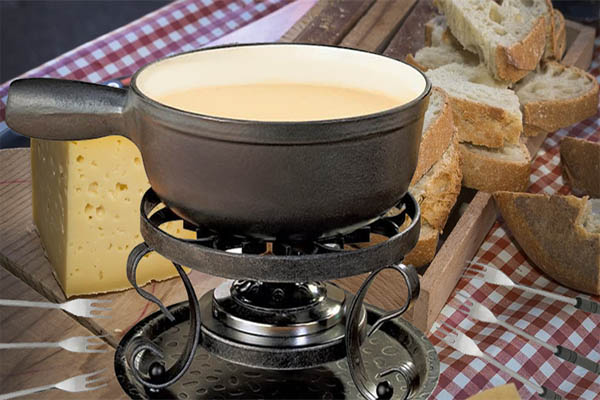Fondues
Welcome your guests with a hot fondue
Chegar Fondue
Ingredients:
1/2 lb grated Gruyère cheese
1 lb grated Swiss cheese
1½ tablespoons cornstarch
1/2 teaspoon nutmeg powder
1/4 teaspoon ground white pepper
1½ cups dry white wine
3 large garlic cloves (minced)
Fresh crusty Italian or French bread cubes
Directions:
1. In a large bowl combine cheeses, add cornstarch, white pepper and nutmeg powder. Toss to coat.
2. In large heavy saucepan bring to boil wine and garlic.
3. Add in spoonfuls of cheese mixture, constantly stirring until melted and smooth after each addition.
4. Transfer mixture to fondue pot placed over low heat.
5. Serve with bread cubes.
Makes 8 to 10 servings.
Tips:
 A cheese fondue mixture should be held at a temperature warm enough to keep the fondue smooth and liquid but not so hot as to allow any burning. If this temperature is held until the fondue is finished there will be a thin crust of toasted (not burnt) cheese at the bottom of the caquelon. This is called la religieuse (French for the nun, more or less). It has the texture of a thin cracker and is almost always lifted out and eaten.
A cheese fondue mixture should be held at a temperature warm enough to keep the fondue smooth and liquid but not so hot as to allow any burning. If this temperature is held until the fondue is finished there will be a thin crust of toasted (not burnt) cheese at the bottom of the caquelon. This is called la religieuse (French for the nun, more or less). It has the texture of a thin cracker and is almost always lifted out and eaten.
 Always prepare the fondue on the stovetop first, then transfer the hot mixture to the fondue pot.
Always prepare the fondue on the stovetop first, then transfer the hot mixture to the fondue pot.

RomWell Cookbook
Discover various delicious and useful recipes...Did You Know?
Civilization in its onward march has produced only three important non-alcoholic beverages—the extract of the tea plant, the extract of the cocoa bean, and the extract of the coffee bean.
Leaves and beans—these are the vegetable sources of the world's favorite non-alcoholic table-beverages. Of the two, the tea leaves lead in total amount consumed; the coffee beans are second; and the cocoa beans are a distant third, although advancing steadily. But in international commerce the coffee beans occupy a far more important position than either of the others, being imported into non-producing countries to twice the extent of the tea leaves. All three enjoy a world-wide consumption, although not to the same extent in every nation; but where either the coffee bean or the tea leaf has established itself in a given country, the other gets comparatively little attention, and usually has great difficulty in making any advance. The cocoa bean, on the other hand, has not risen to the position of popular favorite in any important consuming country, and so has not aroused the serious opposition of its two rivals.

